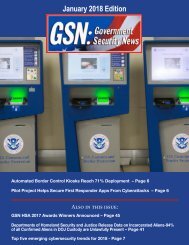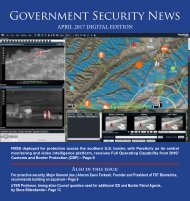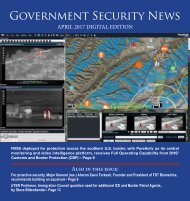GSN_Oct_YUMPU
You also want an ePaper? Increase the reach of your titles
YUMPU automatically turns print PDFs into web optimized ePapers that Google loves.
Pennsylvania sites also attacked by<br />
9/11 terrorists. People eligible can receive<br />
services, no matter where they<br />
live now in the U.S. The director of<br />
the National Institute for Occupational<br />
Safety and Health (NIOSH) administers<br />
the “WTC Health Program”,<br />
paid by the federal government and<br />
New York City. 9<br />
I was invited to participate in research<br />
into the chemical origins of<br />
the “WTC Cough” by the Naval Postgraduate<br />
School in 2010. Because<br />
no chemical-specific detectors were<br />
used, I used an indirect forensic science<br />
public policy approach, noting<br />
that almost all victims suffered<br />
from what is known in medicine as<br />
a “pulmonary edema”, characterized<br />
by fluid accumulation in the lungs,<br />
which collects in air sacs. Shortness<br />
of breath is the most common symptom<br />
of “pulmonary edema” and is due<br />
to the failure of the lungs to provide<br />
adequate Oxygen to the body.<br />
I examined the materials of construction<br />
used in World Trade Tower<br />
Centers 1 and 2 (WTCs), completed<br />
in 1973 and using from 200<br />
to 250,000 tons of common plastic,<br />
Polyvinyl chloride (PVC) as insulation<br />
in the WTCs. When the jet fuel<br />
ignited on “9/11”, the PVC was partially<br />
combusted, forming incomplete<br />
product of combustion chemicals,<br />
and creating from 10 to 15,000 tons<br />
of Phosgene within minutes. Phosgene<br />
is used both in industry and as a<br />
battle field weapon.<br />
The effects of exposure to irritants<br />
such as Hydrogen chloride, Phosgene,<br />
and particulates are dependent on the<br />
size of the particle and how readily<br />
the chemical dissolves in water. These<br />
properties determine where in the respiratory<br />
tract the chemical or particle<br />
is deposited and absorbed. Hydrogen<br />
chloride is very soluble therefore<br />
injury occurs in the upper airway as<br />
opposed to Phosgene, which effects<br />
mainly in the lower respiratory tract,<br />
the lungs.<br />
Phosgene is deadly at a concentration<br />
of 2 ppm. It appears as a white<br />
cloud and has a characteristic odor of<br />
sweet, newly mown hay in lower concentrations.<br />
Phosgene has low water<br />
solubility, so has a delayed onset of<br />
action, from 30 minutes to 8 hours. It<br />
readily reaches the respiratory alveoli<br />
and has direct toxic effects, leading to<br />
cellular damage of the alveolar-capillary<br />
membrane and subsequent pulmonary<br />
edema. 10 Alveoli tubes transfer<br />
O2 into and CO2 out of the lungs.<br />
Because there is no systemic absorption,<br />
other organs are not affected. 11<br />
I observed that when Phosgene reacted<br />
on the moisture of the alveoli in<br />
the lungs it formed corrosive Hydrogen<br />
chloride (HCl). Phosgene had reacted<br />
with the moisture of the alveoli<br />
to form corrosive Hydrogen chloride<br />
(HCl), causing “pulmonary edemas”<br />
in both residents and fire fighters.<br />
However, all Phosgene produced by<br />
the incomplete combustion of PVC<br />
was destroyed by the large amounts of<br />
14<br />
water used to fire the numerous fires<br />
at “Ground Zero”, preventing detection<br />
after “9/11”.<br />
To mitigate human exposure to<br />
Phosgene and other hazardous chemicals<br />
when responding to emergencies,<br />
I am designing and deploying<br />
autonomously operated chemical security<br />
networks capable of detecting,<br />
identifying and measuring not only<br />
Phosgene, but many other chemicals<br />
using a passive standoff chemical<br />
sensor using commercially available<br />
Fourier Transform Infrared (FTIR).<br />
Integrated with video surveillance,<br />
the chemical security “Tool<br />
Box” warns emergency responders<br />
of chemical hazards from up to three<br />
miles away in real-time, preventing<br />
firefighters and other emergency responders<br />
from becoming “canaries in<br />
a coal mine”, protecting both public<br />
health and critical infrastructure.<br />
Editor’s Note:<br />
Published reports within a few days<br />
of the 15th anniversary of 9/11 have<br />
indicated that Christine Todd Whitman,<br />
who was the administrator of<br />
the Environmental Protection Agency<br />
at the time of the 9/11 disaster, has<br />
finally apologized after fifteen years<br />
for her claim in the days immediately<br />
after the attacks that the air around<br />
Ground Zero and in lower Manhattan<br />
was safe. The reports also indicated<br />
that Ms Whitman had stated that<br />
More on page 46















